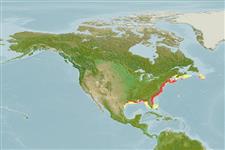Stenotomus chrysops (Linnaeus, 1766)
Scup
添加你自己的观测位置在 Fish Watcher
| Native range | All suitable habitat | Point map | Year 2050 |

|
| This map was computer-generated and has not yet been reviewed. |
| Stenotomus chrysops AquaMaps Data sources: GBIF OBIS |
United States (contiguous states) country information
Common names:
Porgy, Scup
Occurrence: native
Salinity: marine
Abundance: | Ref:
Importance: commercial | Ref:
Aquaculture: | Ref:
Regulations: | Ref:
Uses: no uses
Comments: Also Refs. 4517, 9988, 37512.
National Checklist:
Country Information: https://www.cia.gov/library/publications/resources/the-world-factbook/geos/us.html
National Fisheries Authority: http://www.nmfs.gov
Occurrences: Occurrences Point map
Main Ref: Robins, C.R. and G.C. Ray, 1986
National Database:
Occurrence: native
Salinity: marine
Abundance: | Ref:
Importance: commercial | Ref:
Aquaculture: | Ref:
Regulations: | Ref:
Uses: no uses
Comments: Also Refs. 4517, 9988, 37512.
National Checklist:
Country Information: https://www.cia.gov/library/publications/resources/the-world-factbook/geos/us.html
National Fisheries Authority: http://www.nmfs.gov
Occurrences: Occurrences Point map
Main Ref: Robins, C.R. and G.C. Ray, 1986
National Database:
Common names from other countries
分类 / Names 俗名 | 同种异名 | Catalog of Fishes(属, 种) | ITIS | CoL | WoRMS | Cloffa
Teleostei > Eupercaria/misc (Various families in series Eupercaria) > Sparidae (Porgies)
Etymology: Stenotomus: Greek, stenos = narrow + Greek, stoma = mouth (Ref. 45335).
More on author: Linnaeus.
Etymology: Stenotomus: Greek, stenos = narrow + Greek, stoma = mouth (Ref. 45335).
More on author: Linnaeus.
Environment: milieu / climate zone / depth range / distribution range 生态学
分布 国家 | FAO区域 | 生态系 | 标本纪录 | Point map | 简介 | Faunafri
Western Atlantic: Nova Scotia in Canada to Florida in USA; rare south of North Carolina, USA.
西大西洋: 對美國佛羅里達的加拿大的新斯科舍省; 美國北卡羅萊那州稀有南方。
西大西洋: 對美國佛羅里達的加拿大的新斯科舍省; 美國北卡羅萊那州稀有南方。
Length at first maturity / 大小 / 重量 / 年龄
Maturity: Lm 15.5 range ? - ? cm
Max length : 46.0 cm TL 雄鱼/尚未辨别雌雄; (Ref. 7251); common length : 25.0 cm TL 雄鱼/尚未辨别雌雄; (Ref. 9988); 最大体重: 2.1 kg (Ref. 40637)
Max length : 46.0 cm TL 雄鱼/尚未辨别雌雄; (Ref. 7251); common length : 25.0 cm TL 雄鱼/尚未辨别雌雄; (Ref. 9988); 最大体重: 2.1 kg (Ref. 40637)
Occurs usually in schools inshore in summer and offshore in winter. Feeds on amphipods, worms, sand dollars and young squid (Ref. 4926). Utilized fresh, smoked and frozen; eaten pan-fried, broiled and baked (Ref. 9988). Exported to Japan (Ref. 9988)
在夏天通常生活在鱼群沿海地区与外海冬天时。 吃片脚类动物,蠕虫,沙子元与幼鱼乌贼。 (参考文献 4926) 被烟熏而且冻结的生鲜使用; 吃油锅炸的, 火烤的与烧烤。 (参考文献 9988) 输出了至日本 (参考文献 9988)
在夏天通常生活在鱼群沿海地区与外海冬天时。 吃片脚类动物,蠕虫,沙子元与幼鱼乌贼。 (参考文献 4926) 被烟熏而且冻结的生鲜使用; 吃油锅炸的, 火烤的与烧烤。 (参考文献 9988) 输出了至日本 (参考文献 9988)
Life cycle and mating behavior 成熟度 | 繁殖 | 产卵场 | 卵 | 孕卵数 | 仔鱼
西大西洋: 對美國佛羅里達的加拿大的新斯科舍省; 美國北卡羅萊那州稀有南方。
主要参考文献
Upload your references | 参考文献 | 合作者 | 合作者
Robins, C.R. and G.C. Ray, 1986. A field guide to Atlantic coast fishes of North America. Houghton Mifflin Company, Boston, U.S.A. 354 p. (Ref. 7251)
人类利用
渔业: 商业性; 游钓鱼种: 是的; 水族馆: 公众的水族馆
FAO(渔业: 产生; publication : search) | FishSource | 周边海洋
更多信息
Population dynamics
成长参数
Max. ages / sizes
Length-weight rel.
Length-length rel.
体长-频率
Mass conversion
入添量
丰度
成长参数
Max. ages / sizes
Length-weight rel.
Length-length rel.
体长-频率
Mass conversion
入添量
丰度
Physiology
Body composition
Nutrients
耗氧量
游泳类型
游泳速度
Visual pigments
Fish sound
Diseases & Parasites
Toxicity (LC50s)
Body composition
Nutrients
耗氧量
游泳类型
游泳速度
Visual pigments
Fish sound
Diseases & Parasites
Toxicity (LC50s)
工具
E-book | 野外调查 | 检索表 | 长度- 频率 Wizard | 生活- 历史的工具 | 分布图 | Classification Tree
| Catch-MSY |
特别资料
下载 XML
网络资源
Alien/Invasive Species database | Aquatic Commons | BHL | Cloffa | Websites from users | 核实 FishWatcher | CISTI | Catalog of Fishes(属, 种) | DiscoverLife | ECOTOX | Faunafri | Fishtrace | GenBank(基因组, 核苷酸) | GloBI | GOBASE | | Google Books | Google Scholar | Google | IGFA World Record | MitoFish | Otolith Atlas of Taiwan Fishes | 公众的水族馆 | PubMed | Reef Life Survey | Scirus | SeaLifeBase | 树状分类阶层 | Wikipedia(转至, 搜寻) | World Records Freshwater Fishing | 动物学的记录
Estimates based on models
Preferred temperature (Ref. 115969): 9.4 - 24.6, mean 23.5 (based on 106 cells).
Phylogenetic diversity index (Ref. 82804): PD50 = 0.7500 [Uniqueness, from 0.5 = low to 2.0 = high].
Bayesian length-weight: a=0.01738 (0.01058 - 0.02855), b=3.02 (2.88 - 3.16), in cm Total Length, based on LWR estimates for this species & (Sub)family-body (Ref. 93245).
营养阶层 (Ref. 69278): 3.8 ±0.1 se; based on diet studies.
回复力 (Ref. 120179): 中等的, 族群倍增时间最少 1.4 - 4.4年 (K=0.17-0.23; tmax=19).
Fishing Vulnerability (Ref. 59153): Moderate to high vulnerability (51 of 100).
Climate Vulnerability (Ref. 125649): Moderate vulnerability (40 of 100).




